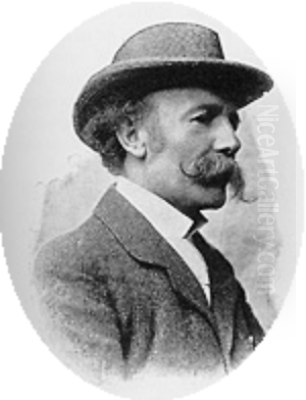
Frederick Morgan stands as a significant figure in the annals of British art, particularly noted for his charming and sentimental depictions of childhood. Active during the latter half of the Victorian era and into the early twentieth century, Morgan carved a distinct niche for himself with paintings that celebrated the innocence, joy, and simple pleasures of youth, often set against idyllic rural backdrops. His work resonated deeply with the public of his time and continues to hold appeal for its technical skill and nostalgic charm. Born in London, this British artist (1847-1927) became one of the most beloved painters of domestic and rustic genre scenes.
Morgan's paintings offered a comforting vision, a world away from the rapid industrialization and social complexities of Victorian Britain. He focused on moments of play, familial affection, and quiet contemplation, rendered with a gentle realism and a warm palette. His ability to capture the fleeting expressions and natural postures of children contributed significantly to his success, making his works highly sought after both as original canvases and as popular reproductions that adorned countless homes. He remains a key representative of a specific strand of genre painting that emphasized sentiment and idealized beauty.
A Painter's Beginnings: Early Life and Influences
Frederick Morgan was born in London in 1847, although some sources cite 1856. He entered a world already immersed in art, thanks to his father, John Morgan (1822-1885). John was himself a successful painter, known for his accomplished genre scenes, often depicting everyday life with narrative detail. Having received training in Paris and London, John Morgan was a regular exhibitor at prestigious venues like the Royal Academy of Arts and the British Institution, establishing a solid reputation within the London art world.
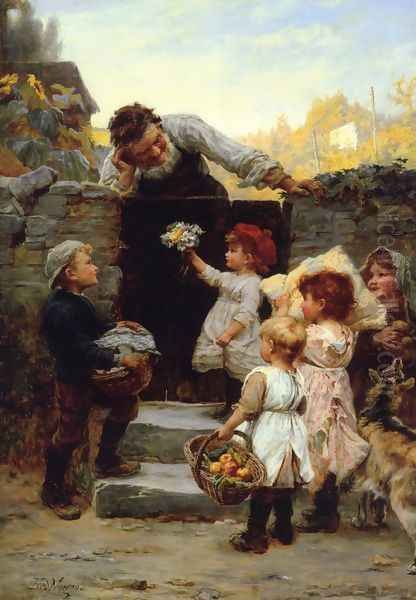
This artistic environment undoubtedly shaped young Frederick's aspirations. He demonstrated an early inclination towards drawing and painting, and his formal artistic education began under the direct tutelage of his father around the age of fourteen. This apprenticeship provided him with a strong foundation in technique, composition, and the narrative conventions of genre painting. The influence of John Morgan's style, with its emphasis on clear storytelling and relatable human situations, can be discerned in Frederick's later work, although the son would develop his own distinct focus and sentimental tone.
Interestingly, despite this artistic lineage, Frederick's path was not initially straightforward. According to some accounts, his father, perhaps concerned about the precariousness of an artistic career or critical of his son's early efforts, initially discouraged him from pursuing painting professionally. John Morgan reportedly suggested that Frederick might be better suited to a different occupation. This paternal skepticism, however, did not ultimately deter the young artist from his chosen path.
First Steps into the Art World
Persistence paid off for Frederick Morgan. At the remarkably young age of sixteen, he achieved a significant milestone by having his first painting accepted for exhibition at the prestigious Royal Academy of Arts in London. The work, titled "The Rehearsal," depicted two elderly musicians practicing, showcasing his early interest in narrative genre scenes, likely influenced by his father's subjects. Its acceptance was reportedly a surprise even to the young artist but marked a crucial public debut.
Exhibiting at the Royal Academy was, and remains, a major goal for aspiring British artists. It provided validation, exposure to critics and potential patrons, and an entry into the established art community. For a sixteen-year-old to gain acceptance was a notable achievement, signaling considerable promise. This early success likely bolstered Morgan's confidence and solidified his determination to pursue painting as his life's work, despite any earlier paternal reservations.
This initial foray into the London art scene set the stage for a long and prolific career. While his thematic focus would eventually shift more decisively towards childhood, "The Rehearsal" demonstrated his foundational skills and his ambition to compete within the demanding environment of the Victorian art world. It was the first step on a path that would lead him to become one of the most popular painters of his generation.
Navigating Challenges: Early Career Hurdles
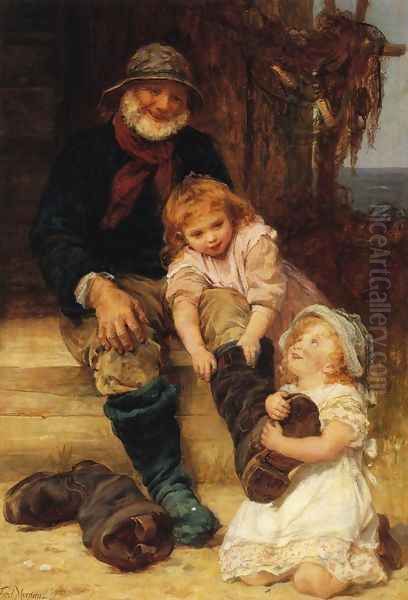
Despite the promising start at the Royal Academy, Frederick Morgan's early career was not without its difficulties. The London art world was highly competitive, filled with established names and emerging talents vying for attention and patronage. Like many young artists, Morgan faced the challenge of distinguishing himself and securing a steady income from his work. Sources suggest that his career experienced a period of stagnation after his initial debut.
Compounding the competitive pressures, Morgan may have also faced health issues during this time, further hindering his progress. Details are scarce, but such setbacks were not uncommon and could significantly impact an artist's productivity and ability to engage with the demanding schedule of exhibitions and commissions. This period of struggle tested his resolve.
To support himself during this challenging phase, Morgan undertook work for photographic studios. This involved painting portraits, often based on photographs, likely for families seeking affordable likenesses. While perhaps not the artistic path he initially envisioned, this commercial work proved unexpectedly beneficial. It provided him with invaluable practice in capturing likenesses and honed his skills in observation and attention to detail – qualities that would become hallmarks of his later, more famous paintings of children. This period, though difficult, ultimately contributed to his technical development.
A Turn Towards Success
A significant turning point in Frederick Morgan's career occurred around 1874. His talent began to attract the attention of influential art dealers, most notably Thomas Agnew & Sons. Agnew's was a major force in the Victorian art market, known for identifying and promoting popular artists. Their interest in Morgan's work marked a crucial step towards wider recognition and commercial success. Securing representation or sales through such a prominent dealership provided validation and access to wealthy collectors.
It was during this period that Morgan solidified his focus on the subjects that would define his career: idyllic scenes of childhood and rural life. Paintings like "The Doll's Tea Party" and "The Departure of the Immigrants" (likely depicting children playing at emigration, a common theme) found favour with the public and dealers alike. These works captured a sentimental view of youth, full of innocence and playful charm, which resonated strongly with Victorian sensibilities.

Morgan often found inspiration and models in the countryside, particularly in the villages around Shere in Surrey, and later near the coast in southern England and even Normandy. These picturesque locations provided the rustic backdrops for his charming vignettes. The growing demand for his work, facilitated by dealers like Agnew's, allowed him to dedicate himself fully to his preferred subjects, establishing the characteristic style that would bring him widespread fame and make him a household name through popular reproductions.
The Heart of Morgan's Art: Style and Subject Matter
Frederick Morgan's artistic identity is inextricably linked to his chosen style and subject matter. He operated firmly within the tradition of British genre painting, which focused on scenes of everyday life, but he imbued his work with a distinct sentimentality and idealized charm. His paintings are characterized by a relatively smooth finish, careful attention to detail in clothing and setting, and a warm, inviting colour palette. The overall effect is one of gentle realism, though often softened and romanticized.
His primary subject was childhood, specifically the portrayal of happy, healthy children engaged in play or simple domestic activities. These scenes were typically set in picturesque rural environments – cottage gardens, meadows, orchards, or beside village lanes. This rustic setting enhanced the sense of innocence and naturalness, contrasting implicitly with the perceived grime and corruption of the rapidly growing industrial cities. Morgan's work offered viewers an escape into a world of simple pleasures and untroubled youth.
The appeal of Morgan's style lay in its accessibility and emotional resonance. He avoided complex allegories or harsh social commentary, focusing instead on universally relatable themes of family, play, and the beauty of the natural world. His figures, particularly the children, were rendered with sympathy and a keen eye for gesture and expression, capturing moments of concentration, joy, mischief, or tenderness. This combination of technical proficiency and sentimental appeal proved immensely popular with the Victorian public.
Capturing Innocence: The Child as Subject
The Victorian era witnessed a profound shift in attitudes towards childhood. Increasingly seen not merely as miniature adults but as beings possessing a special innocence and purity, children became subjects of intense interest and idealization. Frederick Morgan tapped directly into this cultural current, making the depiction of childhood the cornerstone of his artistic output. His work celebrated this idealized vision, presenting children as symbols of hope, happiness, and natural virtue.
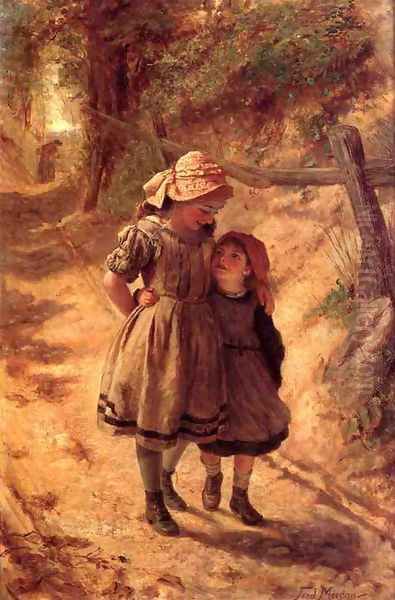
Morgan excelled at capturing the unselfconscious absorption of children at play. Whether depicting a group engrossed in a make-believe tea party, siblings sharing a secret, or a solitary child interacting with nature, he conveyed a sense of genuine engagement. His paintings often explore themes central to childhood experience: the joy of discovery, the intensity of games, the comfort of family bonds, and the quiet wonder of the natural world. Works like "Out of Reach," showing a young girl stretching for a flower, encapsulate this focus on childish desire and innocent striving.
His models were often local children, sometimes his own, whom he observed closely. This allowed him to capture authentic postures and expressions, lending credibility to his idealized scenes. While undoubtedly sentimental, his depictions avoided excessive saccharine sweetness, often incorporating subtle narrative elements or hints of childish determination and concentration. Morgan's focus on the positive aspects of childhood provided a comforting counterpoint to the anxieties of the age and contributed significantly to his enduring popularity.
Masterpieces of Youthful Joy
Throughout his long career, Frederick Morgan produced numerous paintings that became iconic representations of Victorian childhood. Among his most celebrated works is "The Doll's Tea Party," a recurring theme that allowed him to explore children's imitation of adult social rituals with charming earnestness. These scenes often feature meticulously rendered toys, miniature furniture, and earnestly "hosting" children, capturing the seriousness of play.
"The Cherry Gatherers" is another well-known work, depicting rosy-cheeked children happily collecting fruit in an abundant orchard. It evokes a sense of rustic bounty and communal activity, embodying the idealized vision of country life. Similarly, paintings like "Grandfather's Birthday" or "Helping Grandpa" highlight affectionate intergenerational relationships, emphasizing family harmony and respect for elders – cherished Victorian values.
Other popular works capture the simple dynamism of play: "The Swing," showing the exhilaration of flight; "Jump," likely depicting skipping or a similar game; and "Butterflies," focusing on the gentle pursuit of nature's beauty. Titles like "Sisters," "His First Birthday," and "To the Market" further illustrate his focus on familial bonds and everyday rural events. The immense popularity of these images led to widespread reproduction through prints and engravings, making Morgan's vision accessible to a broad audience. An anecdote even tells of a painting featuring Princess Alexandra feeding her dogs finding a place in Buckingham Palace, attesting to his high-level appeal.
Collaboration and Specialization
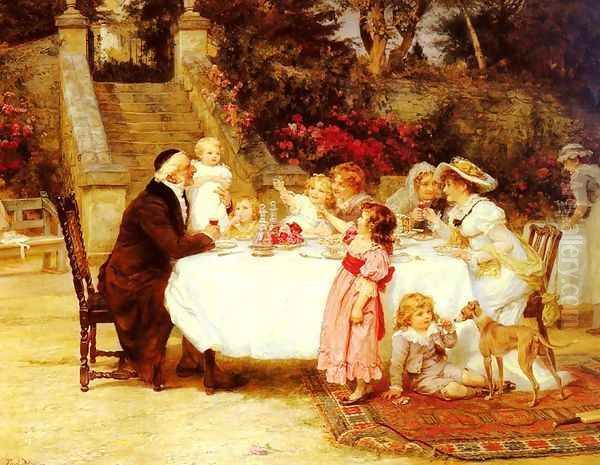
While Frederick Morgan was highly skilled in depicting children and creating appealing compositions, he reportedly found painting animals, particularly dogs and farm animals, more challenging. This led him to collaborate with other artists who specialized in these areas, a practice not uncommon among commercially successful Victorian painters seeking to optimize their output and appeal. These collaborations allowed Morgan to incorporate popular elements like pets into his scenes without compromising on quality.
His most notable collaborator was Arthur John Elsley (1860-1952). Elsley himself became extremely famous for his paintings of children and animals, often sharing a similar sentimental tone with Morgan. Given Morgan's difficulties with animal anatomy, he frequently enlisted Elsley's help to paint the dogs or other creatures featured in his compositions. Their styles blended well, creating seamless and highly marketable images. One specific documented collaboration is the painting "Ruff Play" (circa 1889), which bears the signatures of both artists. This appears to be their only jointly signed work, though Elsley likely contributed animal passages to other Morgan canvases.
Morgan also collaborated with Allen Sealey (active 1850-1927, sometimes spelled Sealy), another artist known for his skill in painting dogs. Sealey specialized in canine portraits and brought his expertise to Morgan's scenes, ensuring the animal figures were rendered with accuracy and appeal. These collaborations highlight the pragmatic aspects of the Victorian art market, where specialization and partnership could enhance an artist's success by catering effectively to popular tastes, particularly the widespread affection for domestic pets.
Morgan in Context: Victorian Genre Painting
Frederick Morgan's career unfolded during the heyday of Victorian genre painting. His work should be understood within this broader context, alongside numerous contemporaries who explored similar themes of everyday life, domesticity, and childhood. His father, John Morgan, provided his initial training and established a foundation in narrative genre painting. His collaborators, Arthur John Elsley and Allen Sealey, shared his market and often his subject matter, particularly Elsley, whose fame eventually rivaled Morgan's in the depiction of children and pets.
Morgan's sentimental and idealized approach can be contrasted with the work of social realists like Luke Fildes (1843-1927), whose famous work "Applicants for Admission to a Casual Ward" depicted the harsh realities of poverty, or Hubert von Herkomer (1849-1914), known for powerful images like "Hard Times." While Morgan offered escapism, these artists confronted social issues more directly. Yet, even celebrated figures associated with other movements, like the Pre-Raphaelite Sir John Everett Millais (1829-1896), achieved immense popular success later in their careers with sentimental genre subjects, such as his famous painting "Bubbles," indicating the broad appeal of such themes.
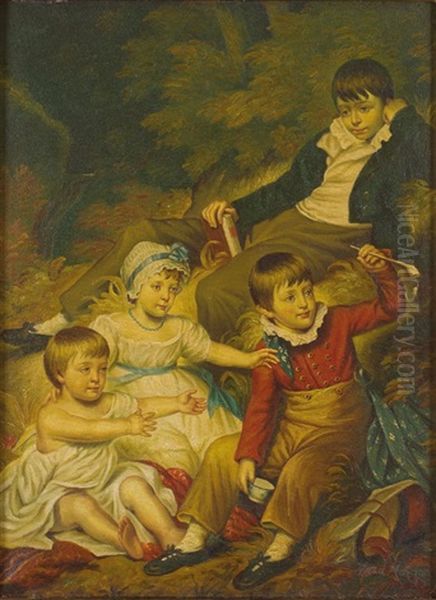
Other contemporaries explored related territory. William Powell Frith (1819-1909) was a master of large-scale, detailed panoramas of modern life like "Derby Day" and "The Railway Station," capturing bustling crowds rather than intimate domestic scenes. Scottish painter Thomas Faed (1826-1900) specialized in often poignant scenes of rural Scottish life, sharing Morgan's interest in rustic settings but sometimes with a more melancholic tone. Painters associated with the Cranbrook Colony, like George Bernard O'Neill (1828-1917), focused on charming, detailed depictions of domestic interiors and family life.
The French-born Sophie Anderson (1823-1903), working in Britain, also gained renown for her highly detailed paintings of children and rural scenes, often with a meticulous finish that paralleled aspects of Pre-Raphaelitism. Furthermore, the influence of illustrators like Kate Greenaway (1846-1901) cannot be overlooked; her distinctive, idealized images of children in quaint costumes profoundly shaped the popular Victorian image of childhood, creating a visual climate in which Morgan's work thrived. Watercolourists like Myles Birket Foster (1825-1899) also contributed significantly to the popular taste for idyllic rural landscapes and cottage scenes, reinforcing the appeal of the settings Morgan favoured. Morgan navigated this rich artistic landscape, finding a specific niche that brought him exceptional popular success.
Exhibitions and Recognition
Frederick Morgan was not only popular with the public and print publishers but also maintained a consistent presence in the established exhibition venues of the time. Over his career, he is said to have exhibited widely, participating in over two hundred exhibitions. His most important platform was undoubtedly the Royal Academy of Arts in London, where he exhibited regularly for many years after his debut with "The Rehearsal." Consistent acceptance at the RA summer exhibition was a key marker of professional standing.
Beyond the Royal Academy, Morgan's work was shown at other significant London venues and regional galleries. The source material mentions exhibitions at the Royal Society of Watercolour Painters, although Morgan was primarily known as an oil painter; it's possible this refers to the Royal Institute of Painters in Water Colours (RI) or perhaps the Royal Society of British Artists (RBA). He also exhibited at institutions like the Manchester City Art Gallery, indicating his reach extended beyond the capital.
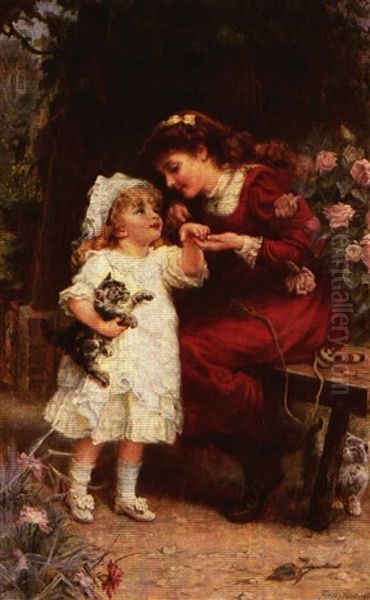
This extensive exhibition record demonstrates his sustained engagement with the formal art world and the consistent quality and appeal of his output. While critical reception may have varied – with some perhaps finding his work overly sentimental – his paintings clearly found favour with exhibition juries and the viewing public alike. This consistent visibility reinforced his status as one of Britain's leading genre painters, ensuring his name and style remained familiar to art audiences throughout his active years. His commercial success went hand-in-hand with this institutional recognition.
Later Years and Enduring Legacy
Frederick Morgan continued to paint and exhibit into the early twentieth century, maintaining his focus on the charming scenes of childhood and rural life that had brought him fame. He adapted slightly to changing tastes but largely remained true to the style and subjects that his audience cherished. He passed away in 1927, leaving behind a substantial body of work that had defined a particular vision of Victorian and Edwardian innocence.
His legacy is multifaceted. Firstly, he stands as a quintessential painter of idealized childhood, capturing a specific cultural sentiment of his era with great technical skill and charm. His works serve as important documents of Victorian taste and the period's romanticized view of youth and rural life. The sheer volume of reproductions made from his paintings attests to his extraordinary popularity and his impact on visual culture, extending far beyond the galleries and into ordinary homes.
Secondly, Morgan's work continues to be appreciated and collected. His paintings appear regularly at auction, often commanding significant prices, indicating a sustained market interest. Major public collections in the UK hold examples of his work, including the Harris Museum & Art Gallery in Preston, Leeds Art Gallery, and the Russell-Cotes Art Gallery & Museum in Bournemouth (likely the institution referred to as Walker-Russell in the source). These holdings ensure his art remains accessible for study and enjoyment.
While artistic styles evolved dramatically in the twentieth century, moving away from the narrative sentimentality Morgan represented, his work retains a historical significance and a nostalgic appeal. He provided a comforting, idealized vision that resonated deeply in his own time and continues to evoke a sense of lost innocence and simpler pleasures for subsequent generations. His influence can be seen less in direct stylistic imitation by later artists and more in his contribution to the enduring iconography of childhood in Western art.
Conclusion: An Enduring Vision of Childhood
Frederick Morgan occupies a distinct and significant place in the history of British art. As a master of genre painting, he specialized in portraying an idealized vision of childhood, set against charming rural backdrops. His work, characterized by technical proficiency, gentle sentiment, and relatable narratives, struck a powerful chord with the Victorian and Edwardian public. He translated the era's growing fascination with childhood innocence into appealing visual form, offering moments of warmth, joy, and domestic harmony.
From his early training under his artist father, John Morgan, through initial career struggles and eventual widespread success facilitated by dealers like Agnew's and collaborators like Arthur John Elsley, Morgan crafted a remarkably consistent and popular body of work. Paintings such as "The Doll's Tea Party," "The Cherry Gatherers," and countless other scenes of youthful play and family life became beloved images, widely disseminated through reproductions.
While tastes in art have shifted, Frederick Morgan's paintings endure. They remain valuable records of Victorian cultural ideals and artistic preferences. More than that, they continue to engage viewers through their skillful execution and their timeless depiction of the universal joys and wonders of childhood. His legacy lies in his ability to capture, with enduring charm, a world of youthful innocence and idyllic simplicity that still holds the power to captivate.